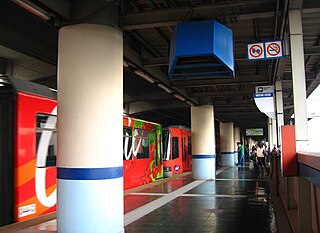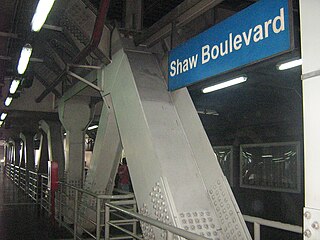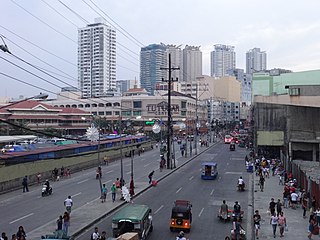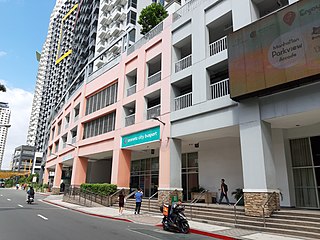
Doroteo Jose station is an elevated Light Rail Transit (LRT) station located on the LRT Line 1 (LRT-1) system in Santa Cruz, Manila. The station is situated on Rizal Avenue and slightly past Doroteo Jose Street. Both the station and the street are named after Doroteo Jose, a Filipino who was arrested by Spanish authorities in 1898 for leading a movement against a corrupt archbishop.

Central Terminal is an elevated Light Rail Transit (LRT) station located on the LRT Line 1 (LRT-1) system in Ermita, Manila. A popular name for the station is Arroceros due to its proximity to the Arroceros Forest Park.

Baclaran station is an elevated Light Rail Transit (LRT) station located on the LRT Line 1 (LRT-1) system in Pasay. Situated on the last stretches of Taft Avenue right at the border with Baclaran, Parañaque, it is the current southern terminus of the line. The terminal is named after the famous shopping district of the same name, which is located on the borders of the cities of Pasay and Parañaque.

Vito Cruz station is an elevated Light Rail Transit (LRT) station located on the LRT Line 1 (LRT-1) system in Malate, Manila. It is the first station from Baclaran and the last station from Fernando Poe Jr. to lie within Manila city bounds. The station takes its name from the former Vito Cruz Street, which was named after a former alcalde mayor of Pineda c. 1871.

Araneta Center–Cubao station is an elevated Light Rail Transit (LRT) station located on the LRT Line 2 (LRT-2) system in Cubao, Quezon City. It is named after the old name of Araneta City, a mixed-use development.

Carriedo station is an elevated Light Rail Transit (LRT) station located on the LRT Line 1 (LRT-1) system along the district boundary of Santa Cruz and Quiapo in Manila.

Katipunan station is an underground Light Rail Transit (LRT) station located on the LRT Line 2 (LRT-2) system in Loyola Heights, Quezon City. It is the only underground station in the entire line. The station is named because of its location on Katipunan Avenue, one of Quezon City's main thoroughfares. The avenue is in turn named after the Katipunan revolutionary society.

V. Mapa station is an elevated Light Rail Transit (LRT) station located on the LRT Line 2 (LRT-2) system in Sampaloc, Manila. It is one of the four stations in the line with a reserve track nearby together with Santolan, Anonas and Araneta Center–Cubao. The station during its inception was formerly called as G. Araneta station but was renamed into the current name due to the minor realignment of some stations that has caused the change of proximity to the V. Mapa Street. The station serves the areas of Santa Mesa, Manila, Quezon City, and San Juan. The station is situated at Ramon Magsaysay Boulevard, near its intersection with Victorino Mapa Street in Santa Mesa, Manila.

North Avenue station Diliman, Quezon City. It is named after its location, which is at the corner of Epifanio de los Santos Avenue (EDSA) and North Avenue, it is the current northern terminus of the line.

Shaw Boulevard station is an elevated Metro Rail Transit (MRT) station located on the MRT Line 3 (MRT-3) system in the Mandaluyong portion of Ortigas Center and is named after Shaw Boulevard, since the station lies directly above the boulevard. Being at the center of the whole line, many commuters regard Shaw Boulevard station as the "central terminal" of the line.

Taft Avenue station is the southern terminus of the Metro Rail Transit Line 3 (MRT-3) system located in Pasay. It is situated at the intersection of Epifanio de los Santos Avenue (EDSA), one of Metro Manila's major thoroughfares, and Taft Avenue usually referred to as Pasay Rotonda or EDSA-Taft. The station is named after Taft Avenue, which is in turn named after former U.S. President and U.S. Chief Justice William Howard Taft, who served as Governor-General of the Philippines from 1901 to 1903.

Boni station is a Metro Rail Transit (MRT) station located on the MRT Line 3 (MRT-3) system in Mandaluyong. It is named so due to its proximity to Boni Avenue, which is in turn named after the nickname of Bonifacio Javier, a World War II guerilla leader and former mayor of Mandaluyong. It has several restaurants and shops that surround the station, including a public market located across the train station.

Pureza station is an elevated Light Rail Transit (LRT) station located on the LRT Line 2 (LRT-2) system in Santa Mesa, Manila. It is named because of its location on Pureza Street.

Anonas station is an elevated Light Rail Transit (LRT) station located on the LRT Line 2 (LRT-2) system in Cubao, Quezon City. It is named because of its location near Anonas Street.

Rizal Avenue, also known as Avenida or Avenida Rizal, is one of Manila's main thoroughfares running from its Santa Cruz and Quiapo districts to the Bonifacio Monument (Monumento) Circle in Caloocan. Named after the national hero José Rizal, it is a part of Radial Road 9 (R-9). The LRT Line 1 elevated railroad is built above the street in its entire length, and several jeepneys ply the area taking passengers from Caloocan, Quezon City, and Valenzuela. Most of the street is within Santa Cruz, Manila. By the 1960s, economic activities shifted from Binondo to Makati. The avenue forms part of National Route 150 (N150) of the Philippine highway network.

Marikina–Pasig station is an elevated Manila Light Rail Transit (LRT) station located on the LRT Line 2 (LRT-2) system in San Roque, Marikina, near the tripoint boundary of Pasig, Metro Manila and Cainta, Rizal. The station is situated on the stretch of Marikina–Infanta Highway near the intersection of Gil Fernando Avenue–Felix Avenue and is named after the cities of Marikina and Pasig which the station straddles between.

Claro M. Recto Avenue, more popularly known as simply Recto Avenue, is the principal commercial thoroughfare in north-central Manila, Philippines. It spans seven districts just north of the Pasig River in what is generally considered Manila's old downtown area.
Tutuban station is a proposed Manila Light Rail Transit (LRT) station situated on Line 2. It is part of the Line 2 West Extension project, a 3.02-kilometer (1.88 mi) extension from Recto station to the Manila North Harbor in Tondo. The west extension project calls for the construction of three additional elevated stations: two on Recto Avenue and one on Zaragoza Street near Pier 4 of the Manila North Harbor. It was approved by the National Economic and Development Authority on May 19, 2015. Ayala Land Inc., will benefit the said station as they already acquired Tutuban Center. Future developments will soon progress at the area the same time with LRT Tutuban Station construction.

The Araneta City Bus Port (ACBP), also styled Araneta City Busport, is a bus station in Quezon City, Metro Manila, the Philippines. The bus station is currently one of two bus terminals in the Araneta City business district that link Metro Manila with the provinces in the north and south of the country, including cities in the Visayas and Mindanao via the Philippine Nautical Highway System.

Tutuban Center is a shopping complex and public transit hub in Manila, the Philippines that opened in 1993. It encompasses five retail buildings and a parking building in and around Manila's central train station located in the shopping precinct of Divisoria in Tondo district. The 20-hectare (49-acre) mixed-use development includes the original two-story brick and iron main terminal building of the Ferrocaril de Manila-Dagupan built in 1887, a declared national historical building by the National Historical Commission of the Philippines since 1934. It also includes the Bonifacio Plaza fronting the old terminal building on Recto Avenue where a statue of Andrés Bonifacio was erected in 1971. Its integrated mall complex houses a mix of wholesale and retail bazaars and covers only 8.5 hectares of the total 20-hectare development. The complex will house the interchange station between the proposed North–South Commuter Railway and an extension of the Manila Light Rail Transit System Line 2 according to the masterplan submitted by the Japan International Cooperation Agency in 2015. Its redevelopment plan also entails the construction of several mixed-use buildings, including office towers, residential buildings, hotels, a convention center, and a 300-metre (980 ft)-high observation tower to be known as the Tower of Maynila.

























